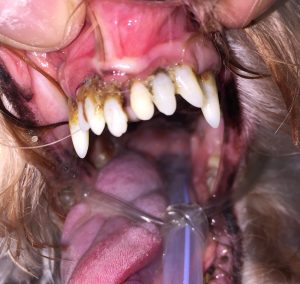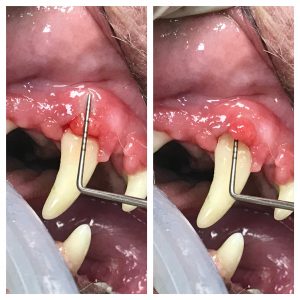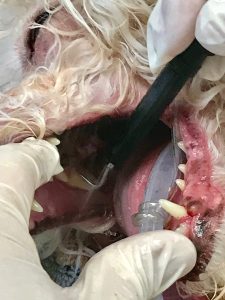6 reasons why Pet Dental Care is done Under Anaesthesia
Think your groomer, or your hygienist friend who brought her tools home, can take care of your pet’s mouth? Think again!
Here are 6 reasons why your pet deserves a proper veterinary dental care program, performed under anaesthesia.
- Dental Disease Hurts! –
Teeth that have a lot of gum recession over them, dental fractures or cavities that are hiding under that big chunk of tartar, even just nerve endings being close to the surface where there are exposed areas of root – all of these are ouchy reasons for your pet to decide NEVER to let you in their mouth again. - Tip of the iceberg – all of what you see if not all that there is. In an awake pet, we may be able to scrape off tartar that is below the gumline; but you CAN NOT get proper scaling under the gumline done.
You yourself may be able to sit still for your hygienist to dig up in there; but your pet does not understand what this is about and will NOT sit still for such a strange and uncomfortable feeling. The result of incomplete cleaning is the teeth look better below the gumline, but continue to rot above the gumline. - X-rays – dental X-rays offer invaluable information about what is going on inside the tooth and down in the tooth socket. A tooth may look fine from the surface, but have a severe pulp infection (endodontitis) inside. A pet needs to be asleep for X-rays – they are not going to figure out how to use bitewings…
- They may need teeth extracted – often you do not know how bad a tooth is until you see the X-ray, and see what is under that tartar. A pet needs to be under anaesthetic just to allow us to put in the freezing injection, never mind actually to remove the bad tooth.
- A full dental program means ALL of the mouth – the inside part that faces the tongue needs cleaning, polishing and examining too. Pets are NOT good at opening wide and saying “aaaahhhh”.
- The lungs don’t want any of that – when the teeth are scaled or polished, many tiny droplets and particles mixed with bacteria are getting flung all over the oral cavity – including to the back of the throat. The endotracheal tube serves not only to deliver the anaesthetic that keeps the pet asleep; it keeps out all of the debris that we do not want down the airway.
Take care of dental disease with proper dental treatment – don’t let fear of anaesthesia cheat your pet of a healthy mouth!



